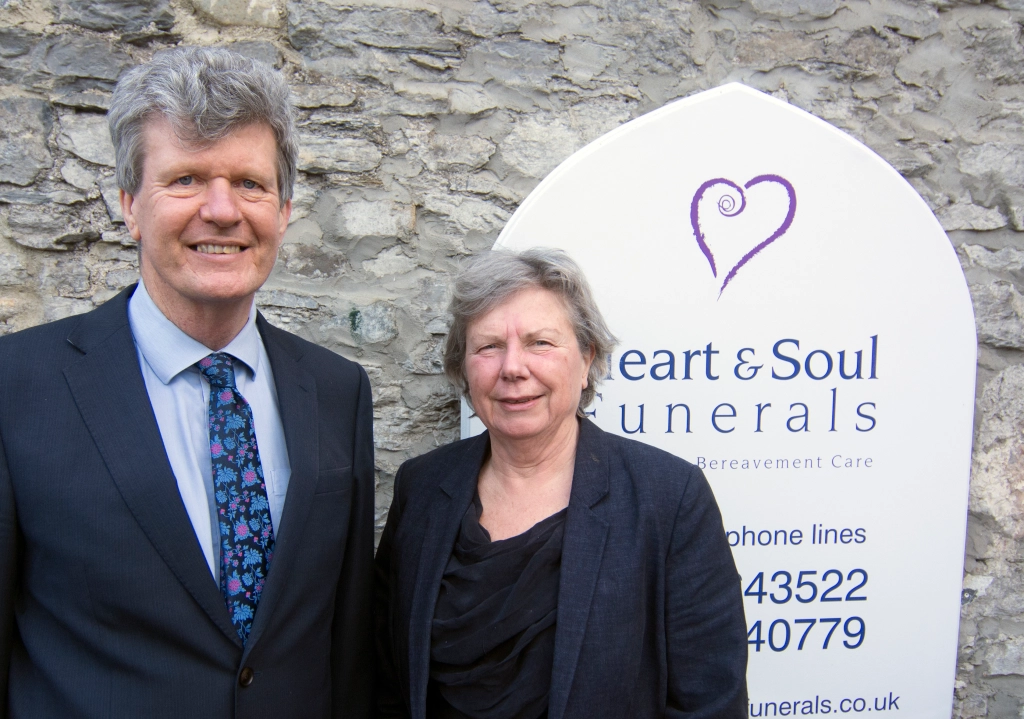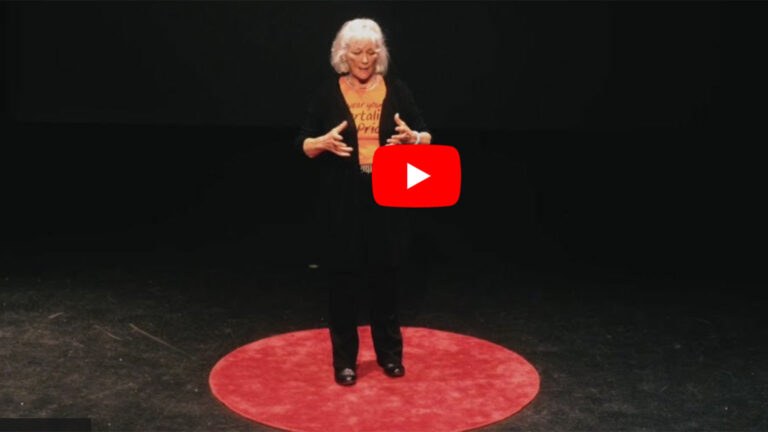
Jane Morrell and Simon Smith set up Green Fuse twenty years ago. It’s been a long journey from setting up in a flower shop with coffins. Jane’s aim was to celebrate rites of passage with flowers and ceremonies. On the first day she opened someone came in whose son had just been found dead in the bath after an overdose. They had no idea he was an addict. This was their first venture into the funeral business and celebration of his life. The funeral work grew and eventually Jane and Simon decided to start training others in the way they worked, both celebrants and funeral directors. They have now trained over 500 people in different aspects of working with funeral directing.
Sue: Welcome Jane and Simon. It’s such a pleasure to talk to you both about Green Fuse and what wonderful work you are doing. Working in the funeral industry isn’t for everyone, so I wondered if you would describe it as a calling?
Jane: I was led into it because of coming through a heavy-duty psychotherapy course, which unveiled what was really driving me. I wanted to create something that was meaningful, and I wanted to combine the two passions of my life which were death and flowers. It just seemed a natural path to take. I suppose what had been ticking away in the back of my mind was my father’s death when I was eight, and the way everyone in the family kept silent about it.
The changing point was when my mother died. I was 36 at the time. I just froze up. Two nights after she died, she came back to me. She stood in the room by my bed, and said, ‘Jane, you did your best.’ The result of that was an immense feeling of love and redemption from my father’s death, which I realised I’d taken on as my fault. I woke up in the morning feeling as if I could start a new day. A new life. I felt completely free and completely loved.
Sue: How about you, Simon? What brought you into this work?
Simon: Well, I’ve always been interested in distress! I think I was the only person working in corporate finance who was doing a counselling course in the evening. My first wife Susie had bad depression and eventually she took her own life. I had to put together Susie’s funeral with her elderly parents and her friends who were in their forties, but I wasn’t given any useful information by either the vicar who was taking the service or the funeral directors. We sort of cobbled together what we could do, and it worked really well. So that’s what got me interested in how people aren’t not told very much apart from the conventional approach to funerals. This was back in 1997 and things have changed tremendously since then especially with the rise of the celebrants.
Sue: Yes, it used to be a bit like going to a doctor who tells you what you should do. And, so did the funeral director. The message was, ‘There ain’t no choice in it.’ How did you get started with training celebrants through Green Fuse?
Simon: We’ve never had a plan. It all just started to happen and then we began training others in 2008 having written We Need To Talk About The Funeral’ in 2006. The leadership work I had been doing previously involved a lot of training and coaching, so I was used to writing and delivering training courses. Our vision was to improve the standard of funerals in the UK. It sounds very grandiose, but we thought that if we started training people in the way we do things, it would have a wider effect than just being a funeral director locally.
Jane: We started by having a lot of communication with the Natural Death Centre. We realised there was a gap in the market – there was only civil ceremonies training at that point. We just saw this enormous gap that needed to be filled.
Simon: We couldn’t understand why funerals had to be boring and drab. And of course, the generational changes were on the horizon. It’s arrived now. The baby boomers are wanting something completely different to my mother’s generation. People want more control over things. They want more information. They want to be able to make their own decisions. They don’t want to be told what to do. So, we are moving out of the very patriarchal way funerals have been put together. But there’s still plenty out there who are doing it that way.
Sue: Yes, there’s a lot more information available about, for instance, how you can keep the body at home, if you want to do that.

Simon: Yes, in the latest 2020 edition of our book, We Need to Talk About the Funeral we try to get that information out to people in a much more general way. After we produced the book in 2006, I remember going into this huge bookshop in Glasgow to ask about books on funerals. On the lowest shelf in the darkest, furthest corner of the shop, they had two books about bereavement. This is how it was greeted by the media and the public, and by the book shop. It wasn’t something that people wanted to look at.
Sue: Thank goodness that’s changing. I’m really interested to know why your celebrants want to train in this work. Have most of them experienced death and grief?
Simon: Most have, yes.
Jane: But on top of that there are people who want to find some meaning in life again. They’ve been working with social services, or they’ve been teachers, or they’re retired, or they’ve been bullied by the system really. And they want to do something with people – to work with people in a meaningful way
Sue: So, it’s about a sense of searching for meaning?
Simon: Yeah, I believe that’s a calling within us all. I eventually realised that I needed to train as a psychotherapist because I needed psychotherapy myself but wouldn’t admit it! I think some people come on our courses because they actually have stuff that they need to work out. The course has been described to us by a few people as a ‘funeral celebrant training with a free personal development course!’
Sue: I can’t imagine you could become a really effective and compassionate celebrant unless you’ve done work on yourself.
Simon: Yeah. We get so cross with these two-day trainings that people go on, and then they go off to be a celebrant. We had one French guy who trained with us and after we hadn’t heard from him for a while, we called him. He told us that after the course he had gone home and hidden under the duvet for three weeks. He had a complete existential breakdown because the thought had never occurred to him that he was going to die!
Sue: Well, that’s quite something! This leads me into what’s really alive for us all right now – which is the message in the media that once you get the Covid jab, you’re not going to die, seemingly ever. I wondered if you want to make a comment about that?
Simon: There’s so much fear around at the moment. But we’re hoping that this will actually stimulate people to think about death and to make plans for it because they feel a bit closer to it than normal. In this last year, people have been very aware of their mortality. There are going to be people who want to run away from it. But there will be people who are thinking this is a reality and we’ve got to get a grip on it somehow. I think a lot of people are beginning to think about how they live and what’s really important.
Sue: But very little has been spoken about the role of pandemics as a natural and organic part of the human experience.
Simon: One of the reasons that we produced the 2020 edition of the book is we want to get more involved in public education about end of life and funerals. We actually look at this as stepping into eldership.
Sue: So, this involves moving away from you holding funerals?
Simon: Yes. We’re talking to a marketing and communications company about how to get people to think and talk about death as a family or have the discussion with friends. This could involve writing things down so they are actually preparing for it and preparing those around them for the fact that one day they will pop off – rather than denying it completely.
Sue: How do you support people to have these conversations when family members don’t want to talk about it?
Jane: That’s the problem. They need coaxing and cajoling and to be given information. That’s what we’re working on. That’s the tough thing. How do you get them to talk?
Sue: Yet there does seem to be a movement towards this, particularly how to help people overcome their fear of death.
Jane: We’ve been listening to Anne Baring lately. She’s a Jungian Psychologist who has made a thread through humanity about how the masculine and feminine became divided, and the way in which the masculine has become so top heavy. But it’s now the turn of the feminine. That’s the transition we are in the middle of right now.
Simon: On a practical level, 85% of the people who respond to our Facebook page are women. Most of the people who come on our courses are women. Most of the people who come into our shop are women. The men are still out there, thinking,‘This isn’t going to happen to me’. So, we think that it’s the women who will be able to start these conversations and to embrace, ‘Come on, guys, we are all going to die. We just need to get real about this.’
Sue: Certainly, in my experience of meeting the new wave of celebrants and alternative green funeral directors, a lot of them are full-on women. It’s really exciting how these women are beginning to take over the funeral industry.
Simon: I went to a meeting funded by the Good Funeral Guide. The Competition And Markets Authority (CMA) had just produced a huge report about the funeral business, and they wanted ten modern funeral directors to talk to the CMA about protecting this new end of the market and not letting the big boys have their own way all the time. Out of those ten companies, I was the only man there and Jane could have gone to make it 10 out of 10.
Sue: Where do you feel this feminine energy is going to take the funeral business?
Jane: If you think of your average funeral director, he’s very remote and authoritative. But a modern female funeral director will sit down with the family and listen. They’ll be much more comfortable, and they will talk about the person who has died and ask questions about them. It’s instantly different. And families will say things to them they may never have spoken about before.
It’s a much less directive approach. The thing about all our training courses is that they teach people to do active listening and to ask open questions to start with. Once a family starts remembering somebody and talking about them things begin firing off in their brains about what would make a good funeral. But if you start off from the point of view of, ‘Do you want a religious ceremony or not,’ or ‘Do you want a burial or cremation?’ or ‘What kind of cars do you want and what coffin do you want?’, none of that creative thinking about the person comes into the picture. No-one’s sparking anything off.
Sue: And it’s all those hushed tones that come with it! I’m just thinking back to when my dad died. A besuited sombre funeral director was sitting behind a big mahogany desk and I was in front of it – a bit like going to see the headmaster.
Jane: I can’t bear the chains they wear!
Simon: Yeah! I went to a meeting to look at some of the issues that traditional funeral directors are coming up against. We made the suggestion that one way that they could make themselves more approachable to the new wave of funeral directors was if they got rid of their chains. They were horrified by the idea!
Sue: I want to talk to you about the new wave of death doulas and soul-midwives who are also now marching up the ranks. They are part of the whole new enclave of what’s happening around the end of life, and I wondered what you thought about them.
Jane: I like them. However, it’s difficult to fit them into the process from where we are because we normally get the notice of the death, not the notice of the illness. When we do get a notice of the illness, we have asked a doula to come in. I think they’re tremendous at what they do. But I don’t know enough about them.
We know people who are doulas and the way they help families to talk and sometimes to accept what’s going on. We had one woman who was terribly lonely because nobody in her family would talk about the fact that she was dying of cancer. She wanted to plan her funeral in advance but within 10 minutes of the meeting starting, her husband walked out. So, we got somebody we know who’s trained as a soul-midwife to go and support them.
Sue: Wouldn’t it be lovely to bring the whole thing into some kind of togetherness?
Simon: Part of the problem is that death doulas have is how to charge for what they do. It’s quite difficult because it can be an open-ended arrangement. For example, we were told by a daughter that her mother was about to die, but she died three and a half years later. You never know how long it’s going to go on. I think hospices are quite suspicious of them in some ways as well.
Jane: It’s different in America. They are used there much more often.
Simon: Even in hospices, it can be difficult to talk about death. But we can go in and talk to patients about things because our job is also about being chroniclers and helping people to tell their life story.
Sue: It’s interesting what you say about hospices. I know of one hospice which has completely rebranded because the word ‘hospice’ is associated with death. I don’t think they have a single reference to death in any of their literature.
Simon: One of the criticisms that I hear about hospices is that you have to die quietly and peacefully. You can’t make any noise or kick up a fuss or anything. But the good thing happening within hospices is the hospice at home movement. We go to the hospice much less often now because the hospice at home service is enabling people to be kept at home until they die.
Sue: Dying at home brings death back into life again, doesn’t it?
Simon: It does, but there are issues as well. I remember we were at a conference once where they asked the question, ‘Would you like to die at home?’ 85% of people put their hands up. Jane then piped up with another question asking, ‘What if it’s really difficult for the people who are around you when you are dying at home?’ The proportion of hands dropped dramatically once they started to think about what it might be like for people caring for them.
Sue: Yes, it’s those logistical issues such as where do you put the hospital bed and the oxygen tent? And if you’re an old person, you probably aren’t able to look after your husband who’s dying in bed.
Simon: That’s what the hospice at home is all about – providing that kind of valuable support. The hospice pays for it because it’s cheaper to have someone at home than in the hospice. Certainly, our two local hospices have reduced their number of beds now.
Jane: I think it’s really good. We’ve been into homes where we can hardly get into such a tiny room, but they’ve got a hospital bed in there somehow.
Simon: I also think there’s a move towards people wanting to keep somebody at home for a while after they’ve died. It might be for a few hours. It might be for 24 hours, and it might be a bit longer than that. The longest we’ve helped to keep someone at home was 10 days after they died. It was a little old lady in the middle of winter, in a north facing room, and she was absolutely fine. Her family wanted her to be with them rather than in someone’s morgue.
Sue: What a lovely gift to give to somebody who’s died. To really respect their body before it’s released into the ground or the fire.
Simon: Yes, we know of families who sit round the bed and have a bottle of wine in the evening and chat over the body. There’s something really good about it.
Jane: It allows people to spend individual time with the body too. They may have a whole of load of things they want to say to the person who’s died. Jerrigrace Lyons heads up a movement called Final Passages, which is all about dying at home. It’s very normal in the States in some sectors. We went out to see her and stayed in the room where her mother had recently died. It certainly had an atmosphere. She had died there; they had washed her body there, and taken her from there to the mortuary.
Sue: Do you feel that dying at home can open us up to something else that’s going on apart from just the physical closing down of the body’s systems?
Jane: We’ve had a number of people reporting things like that. I remember one person telling us that as she was sitting beside her dying father, she felt a sense of a huge lifting up from his body as he died. She was absolutely stunned by the experience.
Simon: We sometimes see marked changes in the bodies that come into us in a state of angst and ‘moving’ into a state of peacefulness over a few days. It’s not just their features, there’s something about the whole aspect of the body, particularly if someone has had a sudden death or when they’ve died in intensive care or they’ve taken their own life. There’s a sense of settling and releasing somehow.
Jane: Yes, sometimes, there’s a sense that someone in the mortuary hasn’t quite gone. I find it’s important to do a little ceremony for them, such as lighting a candle and saying some words, such as ‘go peacefully.’ That seems to change something. They seem to go then.
Simon: I just want to add to this that I reckon only about a quarter of the funerals we do are in a church or a crematorium. We have a beautiful ceremonial hall beside the River Dart. This enables people to hold their ceremony in a much more relaxed atmosphere with no time pressures and no other families coming on the day. If spontaneous things happen, it’s fine and it’s also fine if the service over runs from what was planned. It’s getting people out of the crematoriums into normal spaces, which is another big change. People are also having funerals at home or in a local hotel, halls or outside. It makes it a completely different kind of experience.
Jane: Our families can come in the evening before to decorate the hall in any way they want to, and to lay out the chairs as they wish. They create their own space and have it for the whole day, so they can say their goodbyes in their own time. After the burial or cremation, they can turn the hall around for a celebration of the person’s life.
Sue: I find this so inspiring. It makes me feel so much better knowing there are lots of different ways my body can be really cared for. Is there anything you would like to add about your new vision that is unfolding for you?
Simon: The big thing is starting conversations both within families and getting groups of people together. We have all these trained celebrants out there now, and some of them are interested in us providing them with material so they can run local groups about death. That feels like a good way forward.







